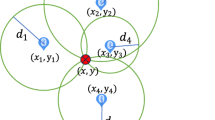Abstract
Device-free passive motion detection seeks to monitor whether there are people moving in an area of interest -the detected individual neither carrying any device nor actively participating in the detection process. This has a very desirable application in mobile computing, such as smart space, asset security, border protection, etc. Many recent works focus on motion detection via WLAN due to its advantages in deployment flexibility, coverage and energy efficiency. However, these don’t consider the influence of human behavior on detection performance. By comparing and analyzing many experiment results, we have found different behavior factors (such as the number and distribution of people, the walking state, the relative distance to the detection point, etc.) have varying effects on detection accuracy using different WLAN information. To transcend these behavioral limitations, we design and implement Bfp: a Behavior-free passive motion detection system utilizing WLAN physical layer information and MIMO technique. First, Bfp extracts CSI information from the physical layer using an off-the-shelf device. Second, we propose to extract the variance of CSI amplitude feature that is more sensitive to human behaviors. Moreover, to eliminate the noise effects, we employ a truncate-tale filter on the variance and then obtain its distribution profile. The earth mover’s distance algorithm is utilized to distinguish the detection results. Finally, multi-streams of MIMO are leveraged to enhance the detection accuracy. Experiment results show our system significantly outperforms the current state-of-the-art in detection rate with different human behaviors.


















Similar content being viewed by others
References
Yang, J., Ge, Y., Xiong, H., Chen, Y., & Liu, H. (2010). Performing joint learning for passive intrusion detection in pervasive wireless environments. In INFOCOM, 2010 proceedings IEEE (pp. 1–9). IEEE.
Kosba, A. E., Saeed, A., & Youssef, M. (2012). Rasid: A robust wlan device-free passive motion detection system. In Pervasive computing and communications (PerCom), 2012 IEEE international conference on (pp. 180–189). IEEE.
Wallbaum, M., & Diepolder, S. (2006). A motion detection scheme for wireless LAN stations. In The 3rd international conference on mobile computing and ubiquitous networking.
Moore, R. S., Howard, R., Kuksa, P., & Martin, R. P. (2010). A geometric approach to device-free motion localization using signal strength. Technical Report Rutgers University.
Zhang, D., Liu, Y., & Ni, L. M. (2011). Rass: A real-time, accurate and scalable system for tracking transceiver-free objects. In Pervasive computing and communications (PerCom), 2011 IEEE international conference on (pp. 197–204). IEEE.
Xiao, J., Wu, K., Yi, Y., Wang, L., & Ni, L. M. (2012). FIMD: Fine-grained device-free motion detection. In ICPADS (pp. 229–235).
Xiao, J., Wu, K., Yi, Y., Wang, L., & Ni, L. M. (2013). Pilot: Passive device-dree indoor localization using channel state information. In Distributed computing systems (ICDCS), 2013 IEEE 33rd international conference on (pp. 236–245). IEEE.
Zhou, Z., Yang, Z., Wu, C., Shangguan, L., & Liu, Y. (2013). Towards omnidirectional passive human detection. In INFOCOM, 2013 Proceedings IEEE (pp. 3057–3065). IEEE.
Abdel-Nasser, H., Samir, R., Sabek, I., & Youssef, M. (2013). MonoPHY: Mono-stream-based device-free WLAN localization via physical layer information. In Wireless communications and networking conference (WCNC), 2013 IEEE (pp. 4546–4551). IEEE.
Sabek, I., & Youssef, M. (2013). MonoStream: A minimal-hardware high accuracy device-free WLAN localization system. arXiv preprint arXiv:1308.0768.
Sen, S., Choudhury, R. R., Radunovic, B., & Minka, T. (2011). Precise indoor localization using PHY layer information. In Proceedings of the 10th ACM Workshop on hot topics in networks (p. 18). ACM.
Zhang, J., Firooz, M. H., Patwari, N., & Kasera, S. K. (2008). Advancing wireless link signatures for location distinction. In Proceedings of the 14th ACM international conference on mobile computing and networking (pp. 26–37). ACM.
Patwari, N., & Kasera, S. K. (2007). Robust location distinction using temporal link signatures. In Proceedings of the 13th anual ACM international conference on mobile computing and networking (pp. 111–122). ACM.
Zhang, J., Kasera, S. K., Patwari, N., & Rai, P. (2011). Distinguishing locations across perimeters using wireless link measurements. In INFOCOM, 2011 Proceedings IEEE (pp. 3155–3163). IEEE.
Liu, Z., Li, Z., Li, G., Zhang, X., & Zhang, H. (2012). A novel motion-detection and edge-detection algorithm based on motion estimation. In Recent advances in computer science and information engineering (pp. 295–308). Berlin, Heidelberg: Springer.
Luhandjula, T., Djouani, K., Hamam, Y., van Wyk, B. J., & Williams, Q. (2012). A visual hand motion detection algorithm for wheelchair motion. In Human–computer systems interaction: Backgrounds and applications 2 (pp. 433–452). Berlin, Heidelberg: Springer.
Youssef, M., Mah, M., & Agrawala, A. (2007). Challenges: device-free passive localization for wireless environments. In Proceedings of the 13th annual ACM international conference on Mobile computing and networking (pp. 222–229). ACM.
Perahia, E., & Stacey, R. (2013). Next generation Wireless LANs: 802.11 n and 802.11 ac. Cambridge: Cambridge University Press.
Rangarajan, S., Kidane, A., Qian, G., Rajko, S., & Birchfield, D. (2007). The design of a pressure sensing floor for movement-based human computer interaction. In Smart sensing and context (pp. 46–61). Berlin, Heidelberg: Springer.
Rubner, Y., Tomasi, C., & Guibas, L. J. (2000). The earth mover’s distance as a metric for image retrieval. International Journal of Computer Vision, 40(2), 99–121.
Acknowledgments
This work is supported in part by the National Natural Science Foundation of China under Grants 61272466, 61303233 and the Natural Science Foundation of Hebei Province under grant F2014203062.
Author information
Authors and Affiliations
Corresponding author
Rights and permissions
About this article
Cite this article
Liu, W., Gao, X., Wang, L. et al. Bfp: Behavior-Free Passive Motion Detection Using PHY Information. Wireless Pers Commun 83, 1035–1055 (2015). https://doi.org/10.1007/s11277-015-2438-7
Published:
Issue Date:
DOI: https://doi.org/10.1007/s11277-015-2438-7




